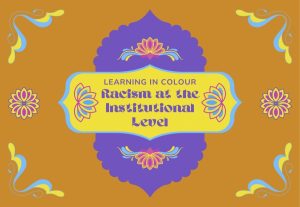22 What Does Racism Look Like at an Institutional Level?

While this site has discussed what racism looks like on a microlevel, it is important to recognize that racism is a structural issue that is enacted by and within institutions, organizations, and systems.
What Does Racism Look Like at an Institutional Level?

The academic institution plays a significant role in perpetuating racism and facilitating a lack of safety on campus for racialized students. When academic institutions are founded on, disseminate information through, and evaluate learning with Eurocentric epistemologies, it can be very challenging for non-white students to navigate the university.
As it pertains to the institutional context, racism can appear in a multitude of ways, including:
- A lack of support for “EDI” (student-led) initiatives
- Whiteness being centered in pedagogy, research, teaching, and learning
- The university community being isolated and distanced from the broader community
- Unaddressed barriers to racialized students’ engagement, access, and participation
We also want to note that institutions are comprised of people in positions of power and authority who have the control and influence to make material changes to policies, procedures, and the systems in place that facilitate inequities. At McMaster University, upper administration – including the President, the Dean of Students, the Chancellor, Faculty Deans, the Head of Security, the Registrar’s Office, upper-level staff in student services (e.g. SAS, EIO, etc.), Ombudsman representatives, and Athletic administration, among many others – have the power to integrate student feedback into the provision of academic, social, health, and well-being services. In this way, they are directly responsible for facilitating safety across campus.
A lack of support for “EDI” initiatives
- Often, student-led initiatives, organizations, and proposed responses to instances of racism on campus are dismissed, underfunded, and/or unfunded, which then contributes to the uncompensated and unrecognized labour that many racialized students are expected to undertake.
- Simultaneously, racialized students’ (and faculty’s) initiatives can be stolen, (mis)appropriated, and misrepresented. For example, some projects led by white folks (e.g. faculty, students, and staff) might receive funding over projects, organizations, and initiatives led by racialized folks. These projects, especially if they are run by the university, might sanitize or dilute more critical insights into the institution and, instead, present “Equity, Diversity, and Inclusion” as something tangible, obtainable, and doable in an oppressive context.
Whiteness being centred in pedagogy, research, teaching, and learning
- As mentioned previously, the foundations of Western academic institutions are rooted in Eurocentric epistemologies, methods, and pedagogies, which is often reflected in and communicated through course syllabi, assignment creation, and assessments of student learning.
- This dynamic is exacerbated by the overrepresentation of white instructors, white administrators, white staff, and, often, white students on postsecondary campuses, in what has been dubbed Predominantly White Institutions (PWIs).
- Research projects and pedagogical initiatives led by white folks might receive more institutional support in both material (e.g. funding) and immaterial ways (e.g. public coverage and celebration) compared to those led by racialized community members.
- Paid positions, scholarships, and coveted roles (e.g. internships) are often perceived as being allocated to white students more than racialized students; few opportunities are specifically created for racialized students.
- White administrators and leadership are visually commemorated in common public spaces in the university (e.g. Gilmour Hall Chambers). While these portraits are displayed in an attempt to appreciate the university’s history, it communicates an exclusivity to racialized students, staff, and faculty that represents many of their experiences in the institution more broadly (e.g. the overrepresentation of white folks in positions of power).
The university community being isolated and distanced from the broader community
- Academic institutions often feel quite separate from the communities that they operate within, take up space in, and benefit from. In McMaster’s case, the greater Hamilton community is often treated as something distinct from the university’s operations, barring particular courses and programs that involve community outreach and work (e.g. placements/internships).
- The separation from the broader community often means that grassroots, community-based organizations doing anti-racist and anti-oppressive work are excluded from the university’s efforts to address these issues. The inclusion of these organizations could facilitate deeper critical analysis of the central issues affecting racialized students, an understanding of the root causes, and transparency about potential ways to address these problems. Solely relying upon university-led responses might facilitate a sense of mistrust in students who feel that their interests are not prioritized if and when they face concerns within the institution. Community organizations could be an essential third-party that works collaboratively with all stakeholders to facilitate a clear, critical, and open process of responding to racism on campus, which would be bolstered by the existing anti-racist work that these organizations have undertaken in the broader community.
- Additionally, students are often framed as McMaster community members, which might obscure, dismiss, or erase the multiple identities that they hold outside of campus boundaries. In other words, things happening outside of the university and in the broader community have real, material, and tangible implications for students on campus, which should not be seen as distinct from their identity as a McMaster student. For example, instances of racism that occur in the local or global community can have significant impacts on students who identify with those affected; while the experience may not have directly or physically involved them or have occurred on campus, it may still affect students in ways that shape their experiences on campus.
- Generally, the broader Hamilton community has historically been – and continues to be – heavily stigmatized for high rates of poverty, addiction, houselessness, and police-reported hate crimes. Many areas of Hamilton and its residents experience significant discrimination, marginalization, surveillance, and violence as a result, particularly as it relates to the intersections of various identities and experiences (e.g. disability, race, class, etc.). McMaster, as an academic institution, might reify and perpetuate these stigmas through its deliberate distancing from the broader Hamilton community, projects that seek to only reaffirm information about issues impacting the city, and student projects or activities that frame community involvement as an ethnographic endeavour (e.g. observing, commenting on, and/or infiltrating communities experiencing these issues).
Unaddressed barriers to racialized students’ engagement, access, and participation
- The arduous and restrictive processes of obtaining financial aid can act as a significant barrier to first-generation, low-income, and non-citizen students. High tuition costs and steep administrative demands to obtain financial aid might act as a deterrent for students seeking to obtain postsecondary education. When many bursaries and scholarships are not specifically designed to support the admission and retention of racialized students, many racialized students may feel unsupported by the institution.
- Similarly, restrictive and limited accommodations related to racialized students’ experiences – and the experiences of those without medical documentation – can adversely affect students’ participation in and engagement with their academic experiences and demands. While some resources are currently available and/or in development, there is an absence of academic support specifically designed for racialized students that recognizes their lived experiences, needs, and contributions.
- As this site has sought to explore, unsafe classroom spaces can be a significant barrier to racialized students participating in their courses. Many participants in our study described feeling severe discomfort stemming from experiences of racism in the classroom, which often resulted in them feeling unable to return and complete the course in person. Moreover, shared and public spaces on campus might also feel unsafe for some students based on previous experiences and/or the composition of the population in that space. When McMaster has had instances of white supremacist postings and social groups operating on campus, the absence of spaces specifically designed for racialized students to gather and/or the realities of what has happened in those public spaces might make them feel unsafe and unable to be actively involved in campus life.
- Many students in our focus group spoke of feeling isolated in their respective courses, programs, and faculties. There is little public data available about acceptance and retention rates of racialized students at McMaster and across its faculties, which many participants described as not being transparent or accountable to EDI claims made by the administration. In other words, students felt that there was a disconnect between what the university claims to value (e.g. equity, inclusivity, diversity) and what actually is happening (e.g. poor representation of racialized students and faculty).
- The things discussed in our project and those that came before us are not new concepts or conversations. Frankly, these experiences have been well-documented and thoroughly explored in academic research, publications, university reports, informal peer support contexts, and grey literature, among others. However, a major issue that participants in our project identified is the ways in which this data has been collected and reported on, yet has not resulted in many material changes that specifically address what students have brought up. As our participants described it, the data seems to “sit in a bucket [and] is never touched again.”
